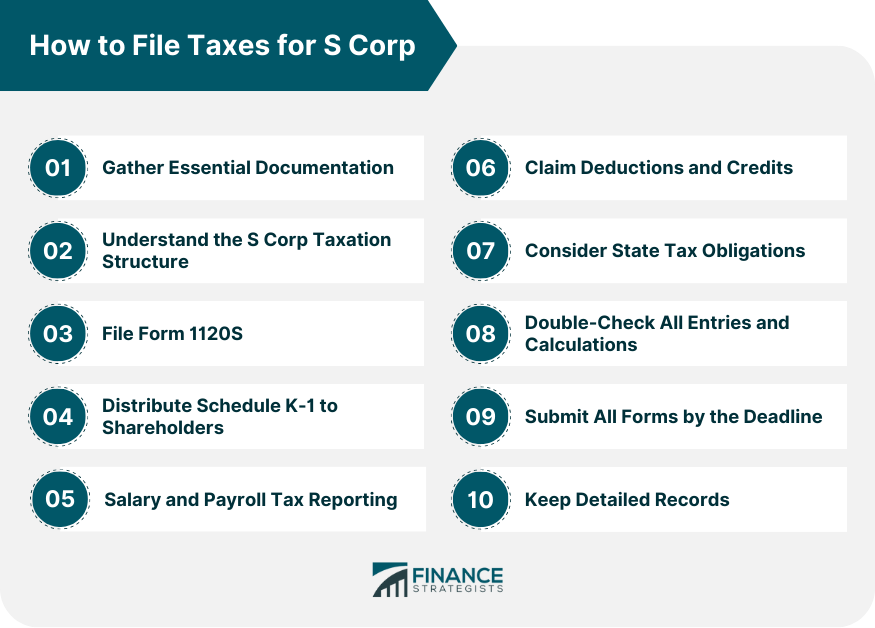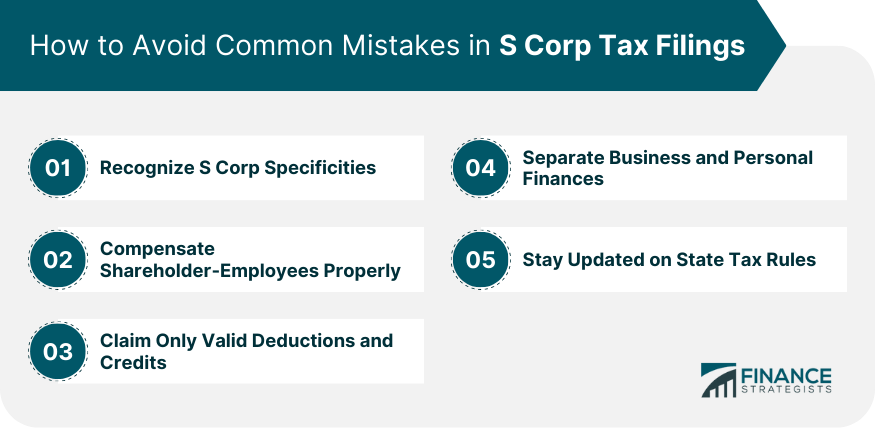An S Corporation is a specific type of corporation that is designed to avoid the double taxation issue that regular corporations (C Corporations) face. S Corp elects to pass corporate income, losses, deductions, and credits through to their shareholders for federal tax purposes. This means that S Corps avoid federal income tax at the corporate level; instead, their shareholders report the corporation's income and losses on their personal tax returns, which can be beneficial for tax efficiency. By properly filing S Corp taxes, businesses ensure they maintain the tax advantages associated with this status. If S Corps do not adhere to the tax requirements, they risk losing their status and could face financial penalties. Additionally, the Internal Revenue Service (IRS) requires detailed documentation of all financial transactions and distributions, making it crucial for the S Corps to maintain meticulous records. Filing taxes for an S Corporation is a multi-step process that requires accuracy, timeliness, and adherence to specific IRS regulations. Here’s a step-by-step guide to ensure you file correctly: This includes preparing annual income statements, balance sheets, and related financial records that detail the company's monetary operations. A special emphasis should be on comprehensive reports covering business expenses, shareholder distributions, and detailed payroll records. Instead of the corporation paying corporate taxes, income, losses, deductions, and credits are directly passed to the shareholders. These financial elements are then reported on the shareholders' individual tax returns, eliminating the risk of double taxation. Grasping this structure is essential to optimize tax benefits and ensure compliance. Form 1120S is the heart of tax filing for S Corporations. This U.S. Income Tax Return for an S Corporation offers a comprehensive overview of the business's financial activities for the fiscal year. It's crucial to fill out this form with precision, ensuring that every detail, from income to deductions, aligns with the corporation's records. Before submitting, a thorough review guarantees accuracy and limits the potential for costly errors or omissions. This form provides each shareholder with a detailed account of their share of the corporation's income, deductions, credits, and more. Completing and distributing these forms in a timely fashion is essential, as they directly influence shareholders' individual tax filings, ensuring they can meet their personal tax responsibilities seamlessly. In the S Corporation, it's common to find shareholders doubling as employees. For such individuals, the IRS mandates the receipt of 'reasonable compensation' for their roles. This dual relationship further entails the accurate and prompt filing of payroll tax forms like Form 941 (quarterly) and Form 940 (annually). By meticulously examining business expenses, an S Corp can identify eligible deductions that reduce taxable income. Additionally, by exploring available tax credits specific to their operations, such as energy efficiency or employee benefits, they can directly reduce their tax bills. Each state possesses its own set of tax rules, forms, and deadlines. Depending on where the S Corp operates, there could be varied tax implications. To avoid potential state penalties and take advantage of available benefits, understanding and fulfilling these state-specific obligations is paramount. Every entry on tax forms should be verified against the company's financial records. While manual verification is essential, using tax software or seeking guidance from tax professionals can further ensure correctness and compliance with all tax-related regulations. Adhering to tax deadlines is critical for S Corporations, typically falling around March 15th. These dates can occasionally vary, so staying updated is vital. E-filing has become a preferred method for many corporations due to its speed and error-checking mechanisms, ensuring timely submissions and confirmations from the IRS. Post tax filing, retaining comprehensive documentation is crucial for any S Corporation. This includes all financial records, tax forms, and related documentation. These records, kept for a minimum of three years, serve as an evidence base during potential audits or inquiries, reaffirming the company's financial declarations and compliance with tax rules. A common error many businesses make is confusing the specific requirements of S Corps with those of other business entities, such as C Corporations or LLCs. To avoid this, always ensure you're up-to-date with the unique stipulations related to S Corporations. This includes understanding the pass-through taxation mechanism, limits on the number of shareholders, and the types of allowable shareholders. Some S Corps might be tempted to reduce salary disbursements in favor of dividend distributions, as the latter isn't subject to employment taxes. However, the IRS mandates that shareholder-employees receive "reasonable compensation" for their services. Periodically reviewing and adjusting salaries in line with industry standards can avoid this pitfall. While S Corps can claim numerous business deductions, not every expense qualifies. Overstepping these boundaries can trigger red flags with the IRS. Regularly updating your knowledge of allowable deductions and credits, and consulting with a tax advisor, can prevent unintentional overclaims. Remember that personal expenses, unless explicitly used for business, typically can't be deducted. For smaller S Corporations, especially when the business owner is the sole shareholder, there can be a temptation to intermingle personal and business finances. This not only complicates financial records but can also lead to inaccurate tax filings. Using separate bank accounts for business and personal transactions and ensuring that any loans between the shareholder and the corporation are properly documented can safeguard against this mistake. Different states have varied tax regulations when it comes to S Corps. Neglecting these specific requirements can result in unintended non-compliance. Also, if the S Corp operates in multiple states, understanding multi-state taxation becomes crucial to ensure compliance across the board. An S Corporation presents a tax-efficient structure that bypasses double taxation. Filing taxes for an S Corp involves meticulous steps to ensure compliance and accuracy. This includes grasping the unique taxation structure, completion of Form 1120S, timely distribution of Schedule K-1 to shareholders, precise payroll tax reporting, identifying eligible deductions and credits, and considering state tax obligations. To steer clear of pitfalls, businesses must recognize S Corp implications, properly compensate shareholder-employees, claim valid deductions and credits, separate business and personal finances, and stay abreast of state tax regulations. With adherence to these guidelines, S Corporations can optimize tax benefits, and maintain financial records in readiness for potential audits. S Corp tax filings require thorough understanding, attention to detail, and alignment with IRS regulations, all of which contribute to a financially sound and compliant business operation.What Is an S Corp?
How to File Taxes for S Corp
Gather Essential Documentation
Understand the S Corp Taxation Structure
File Form 1120S
Distribute Schedule K-1 to Shareholders
Salary and Payroll Tax Reporting
Claim Deductions and Credits
Consider State Tax Obligations
Double-Check All Entries and Calculations
Submit All Forms by the Deadline
Keep Detailed Records

How to Avoid Common Mistakes in S Corp Tax Filings
Recognize S Corp Specificities
Compensate Shareholder-Employees Properly
Claim Only Valid Deductions and Credits
Separate Business and Personal Finances
Stay Updated on State Tax Rules

Conclusion
How to File Taxes for S Corp FAQs
Filing taxes for an S Corporation involves reporting its income, deductions, and credits on Form 1120S. Shareholders receive Schedule K-1 to include on their personal tax returns.
The initial step is gathering essential documents like income statements, balance sheets, and financial records detailing the company's financial activities.
Unlike regular corporations, S Corps pass income and losses to shareholders. This avoids double taxation by having shareholders report on their individual tax returns.
Form 1120S, the U.S. Income Tax Return for an S Corporation, is the core document. Shareholders also receive Schedule K-1, which shows their share of the corporation's financials.
Double-check all entries against company records, especially on Form 1120S. Utilize tax software or seek professional guidance to minimize errors. Also, keep meticulous records for at least three years to support your filings.
True Tamplin is a published author, public speaker, CEO of UpDigital, and founder of Finance Strategists.
True is a Certified Educator in Personal Finance (CEPF®), author of The Handy Financial Ratios Guide, a member of the Society for Advancing Business Editing and Writing, contributes to his financial education site, Finance Strategists, and has spoken to various financial communities such as the CFA Institute, as well as university students like his Alma mater, Biola University, where he received a bachelor of science in business and data analytics.
To learn more about True, visit his personal website or view his author profiles on Amazon, Nasdaq and Forbes.











